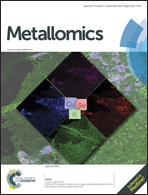Nickel translocation between metallochaperones HypA and UreE in Helicobacter pylori†
Abstract
Incorporation of nickel ions to the active sites of urease and hydrogenase is prerequisite for the appropriate functions of the metalloenzymes. Such a process requires the participation of several accessory proteins. Interestingly, some of them are shared by the two enzymes in their maturation processes. In this work, we characterized the molecular details of the interaction of metallochaperones UreE and HypA in Helicobacter pylori. We show by chemical cross-linking and static light scattering that the UreE dimer binds to HypA to form a hetero-complex i.e. HypA–(UreE)2. The dissociation constant (Kd) of the protein complex was determined by ITC to be 1 μM in the absence of nickel ions; whereas binding of Ni2+ but not Zn2+ to UreE resulted in ca. one fold decrease in the affinity. The putative interfaces on HypA unveiled by NMR chemical shift perturbation were found mainly at the nickel binding domain and in the cleft between α1 and β1/β6. We also identified that the C-domain of UreE, in particular the C-terminal residues of 158–170 are indispensable for the interaction of UreE and HypA. Such an interaction was also observed intracellularly by GFP-fragment reassembly assay. Moreover, we demonstrated using a fluorescent probe that nickel is transferred from HypA to UreE via the specific protein–protein interaction. Deletion of the C-terminus (residues 158–170) of UreE abolished nickel transfer and led to a significant decrease in urease activity. This study provides direct in vitro and in vivo evidence as well as molecular details of nickel translocation mediated by protein–protein interaction.

- This article is part of the themed collection: Nickel in biology

 Please wait while we load your content...
Please wait while we load your content...